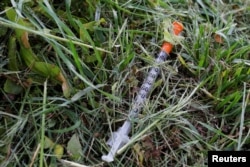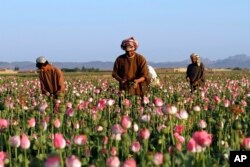The United Nations reports about 250 million people, or 5 percent of the global adult population, used drugs in 2015, and of those, about 29.5 million suffered from drug-use disorders, including addiction.
The World Drug Report 2017 launched Thursday by the U.N. Office on Drugs and Crime (UNODC) said that opioids were the most harmful drug type, accounting for 70 percent of drug-linked health problems worldwide.
It said opioids, including heroin, legal painkillers, such as morphine, and synthetic drugs like fentanyl were responsible for many premature drug deaths.
“In many parts of the world, we observe an increasingly complex relationship between the use of heroin and synthetic opioids,” Aldo Lale-Demoz, deputy executive director of UNODC, said.
Lale-Demoz said that poly drug use — the use of two or more psychoactive drugs — a common feature of both recreational and regular drug users, “as well as the cross-over between synthetic and traditional drugs pose increasing public health challenges and produce highly negative health and social consequences.”
Injecting drugs
Of the 12 million people who inject drugs worldwide, the report found that 1-in-8, or 1.6 million people, is living with HIV and more than half or just over 6 million are living with hepatitis C, while around 1.3 million are suffering from both diseases.
Despite the many health problems afflicting drug users, the report noted that only 1-in-6 people seeking help have access to drug treatment programs.
Lale-Demoz observed that many countries preferred to deal with drug problems by throwing users in prison, which he said exposed them to many infectious diseases.
“The standard of care, which is provided to those who are incarcerated should be equivalent to the care received by those outside the prison system, with appropriate continuity of care between prison and the wider community,” he said.
“Most importantly, we know that alternatives to incarceration for drug offenses of a minor nature actually help reduce the spread and burden of infectious diseases in prison and ultimately within the wider community,” Lale-Demoz added.
Luiz Loures, deputy executive director of UNAIDS, agreed with this assessment noting that “criminalization and health do not go together.”
Loures warned that an injecting drug user who is on the police radar would be reluctant to seek treatment for HIV or another illness for fear of being caught. He said this drives the disease underground, which is dangerous.
“It does not help for the person and it does not help for society. There is plenty of evidence that when you criminalize, the impact on health is negative,” he said. “In my view, one of the major problems today is exactly this confusion between criminalization and access to health. I think that is really not helping, in fact that is fueling the drug use epidemic globally.”
Among its other key findings, the report notes amphetamine use accounts for a large share of the disease burden globally. It said the cocaine market has expanded with the largest number of consumers found in North America and Europe.
The report said global opium production had increased by one-third in 2016 mainly due to higher opium poppy yields in Afghanistan.
Thriving business
Chloe Carpentier, chief of the Drug Research Section at UNODC, told VOA that the Taliban was behind this thriving business.
“We estimate that about $150 million were made by them only in terms of taxing the drug business in 2016, and their revenue would be between $150 and $200 million per year and the drug business would account for about half of what they make per year,” Carpentier said.
Authors of the report concluded that “without the proceeds of drug production and trafficking ... the reach and impact of the Taliban would probably not be what it is today.”
The report noted that organized crime groups were reaping huge profits from the multi-billion-dollar drug trade, generating between one-fifth and one-third of their revenues from these illicit sales.
One of the aims of the United Nations' Sustainable Development Goals is to significantly reduce such illicit financial flows.
“Drug profits is what drives traffickers and, therefore, identifying the flows related to these profits and the channels where they are invested and laundered can effectively counteract them,” the UNODC's Lale-Demoz said.
Ultimately, however, he said drug control was less a law and order issue, and more a matter of personal and public health.
“Sending people to jail, punishing people for minor drug offenses has not worked,” he said. “In fact, it is highly detrimental. It only increases the possibility of all sorts of social dislocations — violence, crimes, stigma and also the spread of diseases.”











